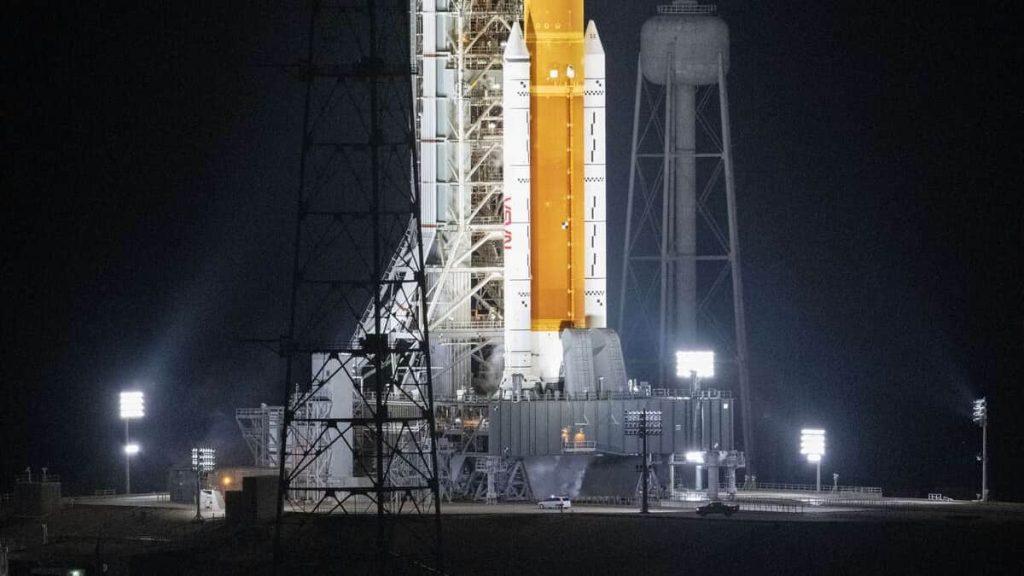After two failed attempts this summer, NASA was set to launch its massive new rocket to the Moon on Wednesday for the Artemis 1 mission, but once again encountered a leak during complex fuel tank filling operations, just hours after launch.
The first flight of the SLS rocket, the most powerful in the world, is scheduled for Wednesday from Florida at 1:04 a.m. local time (0604 GMT), with a two-hour launch capability.
The weather at Kennedy Space Center was cooperative, with 90% favorable conditions.
Filling the rocket with its cryogenic fuel — more than 2.7 million liters of liquid hydrogen and oxygen — began on Tuesday afternoon.
After several hours without a hitch, a hydrogen leak was detected at the foot of the rocket. NASA announced that it would send a team of technicians to the launch pad to tighten the screws. Technically a simple operation, but “considered dangerous” because of the highly flammable fuel, said the NASA live video commentator.
Fifty years after the last Apollo mission, this unmanned test flight, which will circumnavigate the Moon without landing there, should assure the rover is safe for the future crew. The Artemis program aims to send the first woman and first person of color to the moon. The goal is to establish a permanent human presence there to prepare for a trip to Mars.
“A lot of sweat and tears went into that rocket ship,” NASA Administrator Bill Nelson said as the countdown began on Tuesday. “It will allow us to travel back and forth to the Moon and beyond for decades to come.”
Despite the Wednesday night launch, around 100,000 people are expected to enjoy the show, mainly from the surrounding beaches.
“I was too young for the Apollo missions, so I wanted to come in person and see the next moon lift,” Andrew Trombley, 49, told AFP on Cocoa Beach.
Several astronauts have also made the trip to the Kennedy Space Center, including France’s Thomas Pesquet, who told AFP he was feeling “good” just hours before launch. “When that rocket takes off, people are going to be so excited, and realizing that’s it, we’re headed for the truth.”
This summer, the first take-off attempt was canceled at the last moment due to a sensor malfunction, and the second due to an uncontrollable hydrogen leak.
After these technical problems, two Hurricanes – Ian and then Nicole – successively threatened the rocket, delaying its takeoff for several weeks.
In total, the program was years behind schedule, and the success of this multi-billion dollar mission has become a must for NASA.
Immediately after liftoff, crews from the Houston, Texas, control center will take over.
Two minutes later, the two white boosters will return to the Atlantic Ocean. After eight minutes, the main stage in turn separates. Then, about 1:30 after liftoff, a final push from the upper stage will set the Orion capsule on its way to the Moon, which it will reach in a few days.
There, it will be put into distant orbit for about a week, and venture up to 64,000 kilometers behind the moon — a record for a habitable capsule.
Finally, Orion will begin its return to Earth, testing its heat shield, the largest ever. It would have to withstand a temperature about half that of the Sun’s surface as it passed through the atmosphere.
If it takes off on Wednesday, the mission is supposed to last 25 and a half days, with a landing in the Pacific Ocean on December 11th.
After the Saturn V rocket for the Apollo missions, then the space shuttle, the SLS should catapult NASA into a new era of human exploration–this time from deep space.
In 2024, Artémis 2 should take astronauts to the Moon, without landing there. An honor reserved for the crew of Artemis 3, in 2025 at the earliest.
Then NASA plans one mission a year to build a space station in orbit around the moon, called Gateaway, and a base at its south pole.
The goal is to test new equipment there: suits, a pressurized car, a small power plant, the use of ice water on site… all in order to establish a permanent human presence there.
This experiment should bring a manned flight to Mars, perhaps at the end of 2030. This flight, of a very different scope, will take at least two years round trip.

“Hardcore beer fanatic. Falls down a lot. Professional coffee fan. Music ninja.”

![[IMAGES] Someone tries to set himself on fire outside Trump's courthouse](https://m1.quebecormedia.com/emp/emp/Capture_d_cran_2024_04_19_134909afe99a84-cf29-4f06-9dc2-9eb9ce265b46_ORIGINAL.jpg?impolicy=crop-resize&x=0&y=201&w=1074&h=604&width=1200)





More Stories
Pregnant female snow leopard at the Toronto Zoo
When the sun rises Radio-Canada.ca
Parhelia – auditory canal